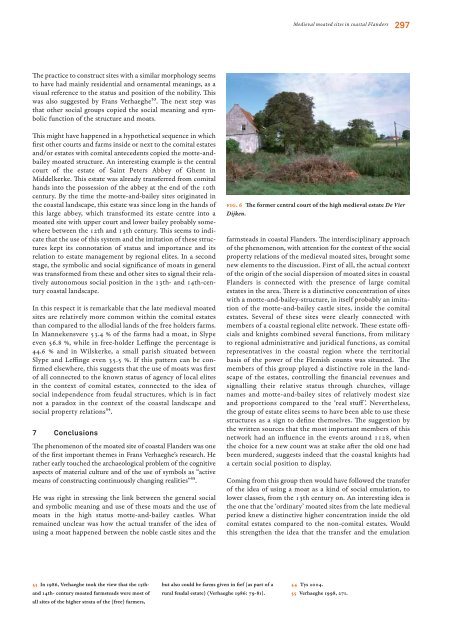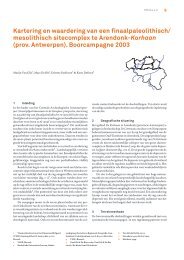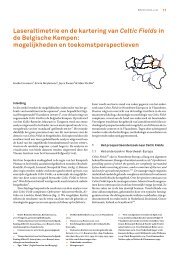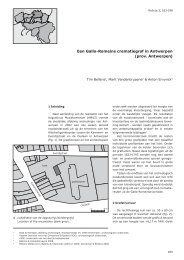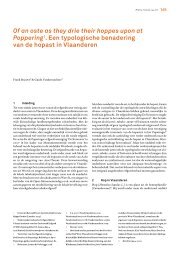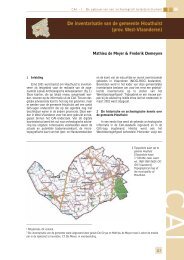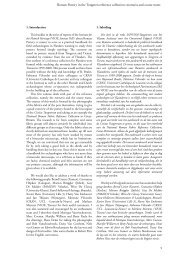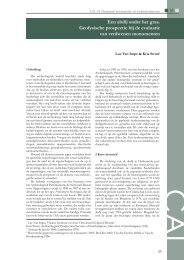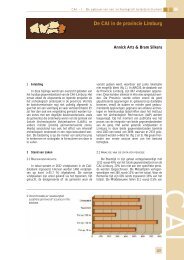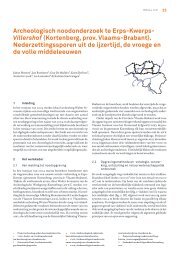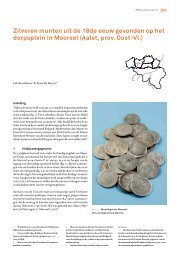Exchanging Medieval Material Culture Studies on archaeology and ...
Exchanging Medieval Material Culture Studies on archaeology and ...
Exchanging Medieval Material Culture Studies on archaeology and ...
Create successful ePaper yourself
Turn your PDF publications into a flip-book with our unique Google optimized e-Paper software.
Th e practice to c<strong>on</strong>struct sites with a similar morphology seems<br />
to have had mainly residential <strong>and</strong> ornamental meanings, as a<br />
visual reference to the status <strong>and</strong> positi<strong>on</strong> of the nobility. Th is<br />
was also suggested by Frans Verhaeghe53. Th e next step was<br />
that other social groups copied the social meaning <strong>and</strong> symbolic<br />
functi<strong>on</strong> of the structure <strong>and</strong> moats.<br />
Th is might have happened in a hypothetical sequence in which<br />
fi rst other courts <strong>and</strong> farms inside or next to the comital estates<br />
<strong>and</strong>/or estates with comital antecedents copied the motte-<strong>and</strong>bailey<br />
moated structure. An interesting example is the central<br />
court of the estate of Saint Peters Abbey of Ghent in<br />
Middelkerke. Th is estate was already transferred from comital<br />
h<strong>and</strong>s into the possessi<strong>on</strong> of the abbey at the end of the 10th<br />
century. By the time the motte-<strong>and</strong>-bailey sites originated in<br />
the coastal l<strong>and</strong>scape, this estate was since l<strong>on</strong>g in the h<strong>and</strong>s of<br />
this large abbey, which transformed its estate centre into a<br />
moated site with upper court <strong>and</strong> lower bailey probably somewhere<br />
between the 12th <strong>and</strong> 13th century. Th is seems to indicate<br />
that the use of this system <strong>and</strong> the imitati<strong>on</strong> of these structures<br />
kept its c<strong>on</strong>notati<strong>on</strong> of status <strong>and</strong> importance <strong>and</strong> its<br />
relati<strong>on</strong> to estate management by regi<strong>on</strong>al elites. In a sec<strong>on</strong>d<br />
stage, the symbolic <strong>and</strong> social signifi cance of moats in general<br />
was transformed from these <strong>and</strong> other sites to signal their relatively<br />
aut<strong>on</strong>omous social positi<strong>on</strong> in the 13th- <strong>and</strong> 14th-century<br />
coastal l<strong>and</strong>scape.<br />
In this respect it is remarkable that the late medieval moated<br />
sites are relatively more comm<strong>on</strong> within the comital estates<br />
than compared to the allodial l<strong>and</strong>s of the free holders farms.<br />
In Mannekensvere 53.4 % of the farms had a moat, in Slype<br />
even 56.8 %, while in free-holder Leffi nge the percentage is<br />
44.6 % <strong>and</strong> in Wilskerke, a small parish situated between<br />
Slype <strong>and</strong> Leffi nge even 35.5 %. If this pattern can be c<strong>on</strong>fi<br />
rmed elsewhere, this suggests that the use of moats was fi rst<br />
of all c<strong>on</strong>nected to the known status of agency of local elites<br />
in the c<strong>on</strong>text of comital estates, c<strong>on</strong>nected to the idea of<br />
social independence from feudal structures, which is in fact<br />
not a paradox in the c<strong>on</strong>text of the coastal l<strong>and</strong>scape <strong>and</strong><br />
social property relati<strong>on</strong>s54.<br />
7 C<strong>on</strong>clusi<strong>on</strong>s<br />
Th e phenomen<strong>on</strong> of the moated site of coastal Fl<strong>and</strong>ers was <strong>on</strong>e<br />
of the fi rst important themes in Frans Verhaeghe’s research. He<br />
rather early touched the archaeological problem of the cognitive<br />
aspects of material culture <strong>and</strong> of the use of symbols as “active<br />
means of c<strong>on</strong>structing c<strong>on</strong>tinuously changing realities”55.<br />
He was right in stressing the link between the general social<br />
<strong>and</strong> symbolic meaning <strong>and</strong> use of these moats <strong>and</strong> the use of<br />
moats in the high status motte-<strong>and</strong>-bailey castles. What<br />
remained unclear was how the actual transfer of the idea of<br />
using a moat happened between the noble castle sites <strong>and</strong> the<br />
53 In 1986, Verhaeghe took the view that the 13th<strong>and</strong><br />
14th- century moated farmsteads were most of<br />
all sites of the higher strata of the (free) farmers,<br />
but also could be farms given in fi ef (as part of a<br />
rural feudal estate) (Verhaeghe 1986: 79-81).<br />
<str<strong>on</strong>g>Medieval</str<strong>on</strong>g> moated sites in coastal Fl<strong>and</strong>ers 297<br />
Fig. 6 Th e former central court of the high medieval estate De Vier<br />
Dijken.<br />
farmsteads in coastal Fl<strong>and</strong>ers. Th e interdisciplinary approach<br />
of the phenomen<strong>on</strong>, with attenti<strong>on</strong> for the c<strong>on</strong>text of the social<br />
property relati<strong>on</strong>s of the medieval moated sites, brought some<br />
new elements to the discussi<strong>on</strong>. First of all, the actual c<strong>on</strong>text<br />
of the origin of the social dispersi<strong>on</strong> of moated sites in coastal<br />
Fl<strong>and</strong>ers is c<strong>on</strong>nected with the presence of large comital<br />
estates in the area. Th ere is a distinctive c<strong>on</strong>centrati<strong>on</strong> of sites<br />
with a motte-<strong>and</strong>-bailey-structure, in itself probably an imitati<strong>on</strong><br />
of the motte-<strong>and</strong>-bailey castle sites, inside the comital<br />
estates. Several of these sites were clearly c<strong>on</strong>nected with<br />
members of a coastal regi<strong>on</strong>al elite network. Th ese estate offi -<br />
cials <strong>and</strong> knights combined several functi<strong>on</strong>s, from military<br />
to regi<strong>on</strong>al administrative <strong>and</strong> juridical functi<strong>on</strong>s, as comital<br />
representatives in the coastal regi<strong>on</strong> where the territorial<br />
basis of the power of the Flemish counts was situated. Th e<br />
members of this group played a distinctive role in the l<strong>and</strong>scape<br />
of the estates, c<strong>on</strong>trolling the fi nancial revenues <strong>and</strong><br />
signalling their relative status through churches, village<br />
names <strong>and</strong> motte-<strong>and</strong>-bailey sites of relatively modest size<br />
<strong>and</strong> proporti<strong>on</strong>s compared to the ‘real stuff ’. Nevertheless,<br />
the group of estate elites seems to have been able to use these<br />
structures as a sign to defi ne themselves. Th e suggesti<strong>on</strong> by<br />
the written sources that the most important members of this<br />
network had an infl uence in the events around 1128, when<br />
the choice for a new count was at stake aft er the old <strong>on</strong>e had<br />
been murdered, suggests indeed that the coastal knights had<br />
a certain social positi<strong>on</strong> to display.<br />
Coming from this group then would have followed the transfer<br />
of the idea of using a moat as a kind of social emulati<strong>on</strong>, to<br />
lower classes, from the 13th century <strong>on</strong>. An interesting idea is<br />
the <strong>on</strong>e that the ‘ordinary’ moated sites from the late medieval<br />
period knew a distinctive higher c<strong>on</strong>centrati<strong>on</strong> inside the old<br />
comital estates compared to the n<strong>on</strong>-comital estates. Would<br />
this strengthen the idea that the transfer <strong>and</strong> the emulati<strong>on</strong><br />
54 Tys 2004.<br />
55 Verhaeghe 1998, 271.


